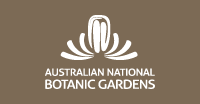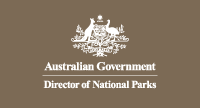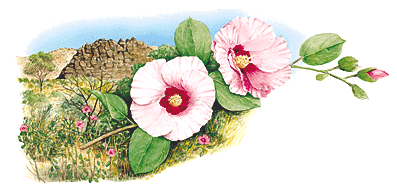 Sturt's
Desert Rose
Sturt's
Desert Rose
Gossypium sturtianum
(plant family: Malvaceae)
Floral Emblem of the Northern Territory
On 12 July 1961, Sturt's Desert Rose was proclaimed* floral emblem of the Northern Territory by the Commonwealth Government which was then responsible for the administration of the Territory. Proclamation was made using the name Cienfugosia gossypioides which is now replaced by the name Gossypium sturtianum var. sturtianum. In an Executive Statement in June 1975, the Majority Leader in the Legislative Assembly of the Northern Territory confirmed this species as the floral emblem. Since the granting of self-government to the Northern Territory in 1978, Sturt's Desert Rose has been incorporated into various insignia and so become symbolic of the region.
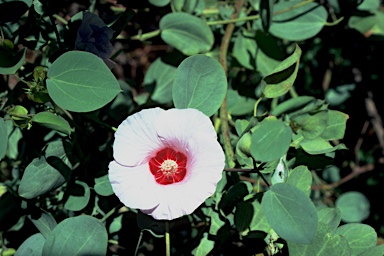 Sturt's
Desert Rose has also been known as Darling River Rose, Cotton Rosebush and Australian
Cotton. Although less widely used, the vernacular name, Australian Cotton, is
appropriate as this species belongs to the genus Gossypium, which includes
commercial cotton. However the hairs covering the seeds are much shorter than
the lint of commercial cotton varieties.
Sturt's
Desert Rose has also been known as Darling River Rose, Cotton Rosebush and Australian
Cotton. Although less widely used, the vernacular name, Australian Cotton, is
appropriate as this species belongs to the genus Gossypium, which includes
commercial cotton. However the hairs covering the seeds are much shorter than
the lint of commercial cotton varieties.
The generic name Gossypium, is derived from the Latin 'gossypion', used by Pliny for the cotton tree, Gossypium arboreum. The specific and varietal names, sturtianum, honour Captain Charles Sturt (1795-1869). The species was first collected by Sturt "in the beds of the creeks on the Barrier Range" during his journey to central Australia in 1844-45. The specimens were "placed at (the) disposal" of the Scottish botanist, Robert Brown (1773-1858), who described the plant in 1849 and named it Sturtia Gossypioides. In Brown's opinion "Sturtia is no doubt very nearly related to Gossypium". The species has undergone several changes in name, and in 1947 J.H. Willis of the National Herbarium of Victoria proposed the name by which it is currently known, Gossypium sturtianum var. sturtianum. The precise number of species of the genus Gossypium worldwide is uncertain, being the subject of controversy among taxonomists - current opinions range from about 20 to 70. The genus is distributed in tropical and sub-tropical areas of Africa, Asia, Australia and the Americas. Gossypium belongs to the hibiscus family, Malvaceae, which is widespread in tropical and temperate regions of the world.
In its natural habitat, Sturt's Desert Rose forms a relatively compact shrub about a metre in height but may reach 2 metres in cultivation. The leaves are dark green usually with black stipples, entire, round to oval in shape and about 5 cm long. The mauve petals are about 5 cm long with red bases forming a contrasting centre in each flower. Flowering is not strictly seasonal but reaches a peak in late winter. The fruit, a capsule, is about 1 cm long and contains many small seeds covered with short silky hairs.
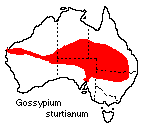 Sturt's
Desert Rose occurs naturally on stony or rocky slopes, or in dry creek beds
in the southern part of the Northern Territory, north-eastern South Australia,
western Queensiand, western New South Wales and in parts of northern Western
Australia.
Sturt's
Desert Rose occurs naturally on stony or rocky slopes, or in dry creek beds
in the southern part of the Northern Territory, north-eastern South Australia,
western Queensiand, western New South Wales and in parts of northern Western
Australia.
This drought-tolerant shrub can be cultivated successfully in areas of low to moderate rainfall. Propagation is possible from seeds and cuttings. An advantage with the latter method is that it provides an opportunity to establish superior forms of the shrub in cultivation. Sturt's Desert Rose tolerates light frosts and in cultivation it responds well to supplementary watering and moderate pruning. Pleasing results are obtained when it is grown as a specimen plant in lawn. Like most members of the hibiscus family, the flowers close soon after picking, limiting its suitability as a cut flower.
Manipulated hybrids between Sturt's Desert Rose and other Australian species of Gossypium bear larger mauve flowers more profusely than either parent. The hybrid between Sturt's Desert Rose and the American species, Gossypium barbadense bears large showy red flowers. Thus the considerable horticultural merit of Sturt's Desert Rose may be enhanced by careful selection of desirable natural forms, as well as hybridisation with other species which occur in tropical Australia, Africa and the Americas.
The blazon of the armorial ensign [illust] assigned to the Northern Territory on 11 September 1978 and recorded in the College of Arms, London, states: 'Growing from a compartment comprising a grassy sandy mound Sturt's Desert Roses (Gossypium sturtianum) ... to be borne for the said Northern Territory upon Shields Seals Banners Flags or other-wise according to the Laws of Arms'.
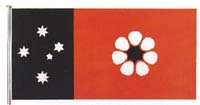 As
the Northern Territory approached self-government, the appropriateness of a
territorial flag was realised. The Northern Territory Government invited members
of the public to submit proposals for the design of a flag. Some of these suggestions
provided a basis for the design by the Australian artist, Robert Ingpen. It
depicts, in the official colours, black, white and ochre, Sturt's Desert Rose
in stylised form, together with the Southern Cross constellation. Mounted on
an ochre panel, the seven white petals and the seven-pointed black star forming
the flower's centre, represent the six Australian States and the Northern Territory.
This flag was raised for the first time on 1 July 1978, in a ceremony marking
the granting of self-government.
As
the Northern Territory approached self-government, the appropriateness of a
territorial flag was realised. The Northern Territory Government invited members
of the public to submit proposals for the design of a flag. Some of these suggestions
provided a basis for the design by the Australian artist, Robert Ingpen. It
depicts, in the official colours, black, white and ochre, Sturt's Desert Rose
in stylised form, together with the Southern Cross constellation. Mounted on
an ochre panel, the seven white petals and the seven-pointed black star forming
the flower's centre, represent the six Australian States and the Northern Territory.
This flag was raised for the first time on 1 July 1978, in a ceremony marking
the granting of self-government.
Both the armorial bearings and the stylised form of Sturt's Desert Rose are used widely on official stationery, advertising and publications. The stylised form of the floral emblem is easily identified and readily associated with the Northern Territory, despite the assigning, for symbolic reasons, of an additional two petals to the normally five-petalled flower.
Stamps featuring Sturt's Desert Rose as the floral emblem of the Northern Territory were of three values, 2 cents [illust], 4 cents and 6 cents, issued on 1 October 1971, 27 April 1970 and 28 September 1970 respectively. They supplemented the set of six stamps issued in 1968 depicting the floral emblem of each of the six Australian States. The granting of self-government was commemorated by the issuing on 19 June 1978 of an 18 cent stamp [illust] designed by Douglas Pitt, depicting Sturt's Desert Rose beneath a map of Australia with the Northern Territory delineated.
Download a line illustration by Marion Westmacott.©
Download copyright-free illustration by Fay Davies, suitable for childrens' colouring.
* Northern Territory Gazette No 32 19 July 1961 p142 (498/32)
Written by Anne Boden for a booklet published by AGPS for the ANBG in 1985.
![An Australian Government Initiative [logo]](/images/austgovt_brown_90px.gif)





